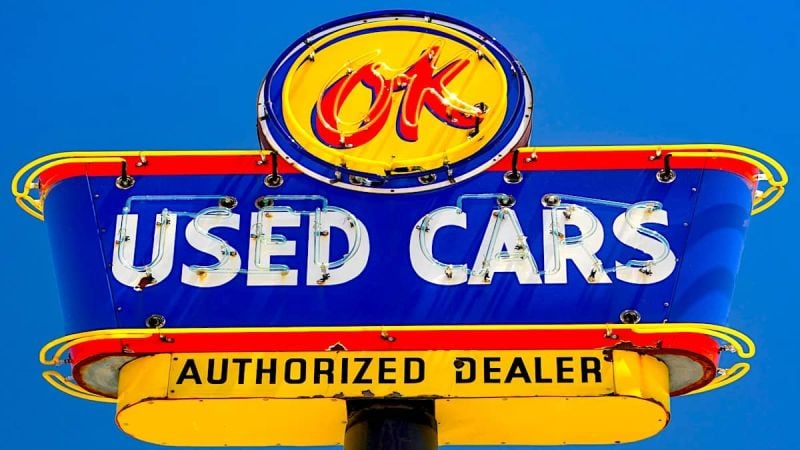There is little else worse than finding out too late than that a used car you just bought is more lemon than cherry. It happens to the best of us. Sometimes that repair was just a pothole away from revealing itself, but other times it involves some deliberate omission of history or just a plain scam band-aid fix by the seller. In any case, nowhere more is “buyer beware” a mantra all potential used car buyers should mutter silently as they look over a potential used car purchase.
Thankfully, sources like Consumer Reports offers some very good money and stress saving advice to help prepare you ahead of time before you answer that ad in the paper for a used car deal that caught your attention.
That said, below is a summary of what the mechanics of Consumer Reports have to say about how to find hidden problems in a used car before buying one.
Consumer Reports Used Car Hidden Problem Check List
1. Check the Reliability Record of the Vehicle---Before you even pick up a phone and arrange to meet with a private seller or a used car dealer, now is the time to find out if that vehicle for sale is one that you really want to take a chance on…even if it appears to be in great condition with acceptable mileage.
The point is this: many vehicle makes and models have unique problems such as AC failures, drivetrain and transmission problems, and even engine catastrophes that occur statistically higher than other makes and model. And this changes year to year between models. The good news is that you can check on the reliability of almost every make and model over the past 10 years by visiting automotive sites like this one; and, of course---Consumer Reports. Do your research to find out if that used vehicle is approaching its shelf life for a repair that could be prohibitively expensive if it happens to you.
And while you are doing your research, it also pays to go to the National Highway Traffic Safety Administration website and search for any recall alerts on the model of car you are considering as well as Technical Service Bulletins, or "TSBs,” which are reports that a manufacturer sends its dealers about common or recurring problems with a specific model, and how to fix them. If you are considering buying a used car with a recall or TSB history, be sure to ask if the problem was fixed and that the seller shows proof it was done.
2. Read the Window Sticker---dealerships are required to post a window sticker alerting the potential buyer as to whether the vehicle is being sold “as-is” or if it provides any type of warranty. Treat that window sticker like a contract, because essentially it is. If you have an issue with the car before agreeing to buy it, you can ask the seller to rewrite the sticker to include coverage of your concern. And as for those “as-is” offers, you have no one but yourself to blame if something goes wrong later.
3. Check the Exterior---here is where you give a car the walk-around from a distance and just look for something that doesn’t seem right like irregular gaps between doors or the hood with the body; mismatched paint on the body like door and fenders and bumpers; and, most importantly of all---tell-tale overspray where someone tried to hide a defect or some damage, but accidently got the spray on surrounding trim or bumpers.
Your next walk around should be a done close to the vehicle to pick up on some less obvious signs of damage or repair that could reveal some hidden work done to the vehicle. Be sure to look closely at all glass for evidence of small cracks easily missed.
4. Check the Interior---go over the inside of the car like you are looking for some loose change to buy a badly needed soda on a hot day. However, never stick a hand blindly between the upholstery. Don’t ask. Check of smells too; If the windows just happen to be open when you arrive, be sure to close them and determine if there are any musty odors indicating leaks or a mold problem in the AC system.
Look for silt under the carpeting, rusting floorboard screw heads, and intermittent electrical problems that could be a sign of flood damage. Push all buttons, pull and twist all knobs, make sure every feature works…or not. Damaged seat belts could be a sign of a frontal impact. And, note the condition of the pedals and the wear on the seat---over-wear on any of these indicate a lot of miles were spent on this vehicle and/or that the odometer may have been altered.
5. Check Under the Hood---Again, take a look over the overall condition from a slight distance to take in just how filthy or clean an engine looks. It’s kind of like you can’t see the forest for the trees kind of thing. Then get up close and go over every belt, hose, and wire to look for wear, leaks, aged cracking, and melting either electrical or from an engine over-heating. Is the firewall or the underside of the hood suspiciously darkened?
Check all of the fluid levels both cold and after the engine has been running for 10 minutes. If it was properly maintained it will have the correct levels. Be sure to take note of the fluid conditions. According to Consumer Reports:
Normal engine oil is brown or black, depending on when it was last changed. Gritty or gelatinous oil may indicate long stretches between oil changes. Thin, frothy oil that’s the color of chocolate milk may point to a blown head gasket or to a severely damaged block or cylinder head. Fine metal particles in the oil indicate internal damage or heavy wear.
I would also recommend running a magnet along a wet oil dipstick to see if any fine metal particles pull out of the oil.
And when it comes to the transmission fluid, its color should be bright red to light reddish brown, not dark brown, black, or mustard colored---those colors can indicate serious problems. Also, if the fluid has a strong burned smell, this too indicates possible severe wear.
While it may seem obvious, be sure to go through all the gears while the engine is running, and take it for a ride around the neighborhood. However, a test run on the highway is important too as higher speeds can reveal engine as well as suspension problems.
6. Check the Steering---while test driving, pay particular attention to how the steering feels and whether there is excessive play with the steering wheel and/or vehicle wandering that requires adjusting the steering wheel quite a bit---all of which can reveal a potential problem with the steering linkage, front end alignment, wheel imbalance and/or a suspension/frame problem.
7. Check the Suspension---speaking of suspension, don’t be afraid to push down hard on the body over the wheels to see if you get more than a couple of soft bounces. More than two rebounds indicate worn shock absorbers or struts.
A better test though is to take a 30 mph run on a rough road and (my favorite) speed bumps. If you feel and hear the body jar or slam against the frame, you will know that there is an expensive problem afoot.
8. Check the Tires---tire wear can tell you many things about how the condition of a vehicle and how it has been handled:
Wear should be even across the width of the tread and the same on the left and right sides of the car. Tires that are overinflated tend to have more wear in the middle; tires driven while underinflated tend to wear more on the sides.
Heavy wear on the outside shoulder near the sidewall of a tire indicates a car that has been driven hard. This can be a sign that other parts of the car may suffer from excessive wear due to aggressive driving. Cupped tires, those that have worn unevenly along the tread’s circumference, can indicate various problems with the steering, suspension, or brakes.
9. Check the Tailpipe as Soon as the Vehicle is Started---looking for smoke signals coming out of the exhaust when an engine is fired up can reveal the following:
White Smoke: An initial puff or so of white smoke upon startup is likely due to condensation burning off and is not a problem. However, Billowing white smoke indicates water in the combustion chamber, usually because of a blown head gasket, a damaged cylinder head, or even a cracked block.
Black Smoke: Seeing persistent black smoke after the car has warmed up indicates an overly rich air-fuel mixture usually due to a dirty air filter, a faulty oxygen sensor, or a defective mass-air meter.
Blue Smoke: Blue smoke caused by oil burning is a bad sign and should be a deal breaker for any used car buyer.
10. Step on the Gas---When accelerating, pay attention to the engine and transmission. Is the engine overaccelerating indicating transmission troubles? Hear some pings and knocking coming from an engine with timing problems or is overheating? If it does not sound right---it’s not, and will require a mechanic to diagnose the extent of the problem.
11. Check the Vehicle’s History--- a vehicle history report from such services as CarFax or Experian Automotive can alert you to possible odometer fraud; reveal past fire, flood, and accident damage; or tell you if a rebuilt or salvage title has ever been issued for the vehicle. While not 100% guaranteed to have a complete history available on your particular car, it’s a worthwhile search that could save you a lot of headache later on.
12. Go to a Mechanic---Last, but certainly not least, taking the vehicle to a mechanic skilled at diagnostics and repair is an added expense, but one that can save you from a lemon and/or help you negotiate a lower price if you still want the car and the mechanic assures you that it’s a keeper with a little work.
And finally…
Now that you’ve got the basics down on what to look for while checking out a used car, here’s a little bit more from Consumer Reports with this humorous (but useful) video that touches on how to prepare yourself ahead of time before walking onto the lot and dealing with a used car salesman.
Tips for Buying a Used Car | Consumer Reports
For more about used cars, new cars, car maintenance and repair, be sure to check out our site and try its search engine for useful articles on any car model you may have questions about through a database filled with informative reviews by car experts.
COMING UP NEXT: See how one car owner is converting his old Ford into an EV using used Tesla battery packs.
Timothy Boyer is Torque News Tesla and EV reporter based in Cincinnati. Experienced with early car restorations, he regularly restores older vehicles with engine modifications for improved performance. Follow Tim on Twitter at @TimBoyerWrites for daily Tesla and electric vehicle news.
Photo by Jim Witkowski on Unsplash












Comments
There is a reason people
Permalink
There is a reason people trade in cars. Aside from leases ending, very few people trade in perfectly good cars. Most used cars will have some sort of issue. If every used car buyer followed this checklist verbatim, they would never buy anything other than a brand new car. This article basically says if the car isn't perfect, don't buy it. That is impractical when buying used.
Well, I can see your point,
Permalink
Well, I can see your point, but this was more of a buyer-beware message. Forewarned is forearmed and all that. Many people don't know the first thing to look for in a used car and this may help them make an informed buying decision without losing money needlessly on something that is not worth the price asked. Once you know the issues with a used car, you can use that to bargain down the price with, if it's a specific model you really want for whatever reason. And then use the savings to pay for those repairs. Used cars have a long history of auto-scams, this was meant to raise awareness and provide some advice on how to approach a used car. Thanks for the input.